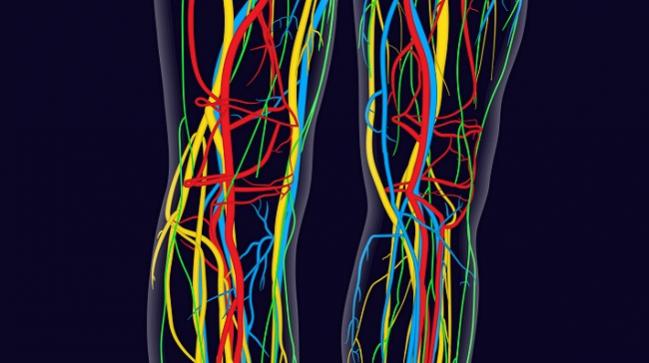Noninvasive Testing of CLI: Many Ways to Draw Up a ‘Roadmap’
At ISET 2018, one expert outlined the options for clinicians who want to get the right diagnosis in this challenging patient subset.

HOLLYWOOD, FL - Clinicians seeking to pinpoint the location and severity peripheral artery disease in patients with critical limb ischemia (CLI) should tailor the test to the patient, keeping in mind there are numerous noninvasive options beyond the standard ankle brachial index (ABI) and toe pressure measurement, Raghu Kolluri, MD (OhioHealth Riverside Methodist Hospital, Columbus, OH), told attendees yesterday at the International Symposium on Endovascular Therapy (ISET) 2018.
Each of these tools, including pulse volume recordings, duplex ultrasound testing, transcutaneous oxygen (TcP02) measurement, and testing of skin perfusion pressures, may have clear advantages in some patients, but not others, he added.
For CLI patients with diabetes and renal insufficiency in particular, noninvasive testing can provide a “roadmap” of PAD to guide interventions, Kolluri told TCTMD. “In these patients, time is of the essence. You have to act in a timely manner. So you don’t want to get them a CT scan, give them the contrast load, then take them to the cath lab and give them another contrast load, unless it’s absolutely necessary. That’s why for critical limb ischemia we just bypass axial imaging and use our noninvasive lab in most cases.”
What are we trying to achieve with this noninvasive test? Have we gotten any information from this that is sufficient? Raghu Kolluri
ABI has the advantage of being obtained via a simple office test that can be done either before or after revascularization. Tests for segmental pressure and pulse volume pressure also have these strengths. Yet, in patients with calcification or stiff vessels, the results can be unreliable. Toe pressures, too, “are not always reliable,” Kolluri said in his presentation. For example, a patient who smokes a cigarette just prior to testing may have “poor toe pressures due to vasospasm.”
Situations that are less than straightforward, he said, raise questions: “What are we trying to achieve with this noninvasive test? Have we gotten any information from this that is sufficient?”
Moreover, standard approaches to testing may not even be possible. Some patients, due to ischemic ulcers, cannot tolerate the use of blood pressure cuffs. Others may have a prior amputation, meaning that measurement of ABI or toe pressures is out of the question.
Arterial duplex ultrasound, which can be done prior to angiography, is an “excellent” alternative, especially in patients with renal injury, Kolluri suggested. It is widely available, he said, and for measurements from the central femoral artery to popliteal artery “does not require high technical expertise.”
Finally, TcP02, which measures oxygen pressures on the skin’s surface, reflects how much oxygen is being delivered to the skin by the blood, Kolluri explained. Values are thought to predictive of ulcer healing, though this concept is “somewhat controversial,” he added. Pressures of less than 30 mm Hg fall in the “ischemia and nonhealing range,” while those falling between 30 and 70 mm Hg can still result in ulceration, Kolluri said. Although sometimes TcP02 may be the only option, it can also be used as an adjunct to other tests. After revascularization, it can be used to assess improvement, and it can be also inform patient selection for hyperbaric oxygen therapy.
Yet TcP02 is not without limitations. It must be assessed in a temperature-controlled environment of around 23°C (73.4°F). Falsely low values can arise in patients with edema, cellulitis, or central hypoxemia, and the test’s reproducibility is “moderate to poor” compared with ABI, Kolluri reported.
Still another option is skin perfusion pressure testing, which uses laser Doppler to assess reactive hyperemia, he added.
Go for an Individualized Approach
During the session, several people asked Kolluri about his own “algorithm” for who among his center’s CLI patients gets which tests. Everyone undergoes ABI and toe pressure testing when possible, he explained, going into detail about various scenarios.
To TCTMD, Kolluri said that not all vascular specialists may be aware of the noninvasive imaging options they have at their disposal and even those who are may choose different paths.
Clinicians should remember that “each person is different, each intervention is different,” he stressed. Patients can be grouped according to severity of disease and initial testing results, then stratified to undergo additional evaluation. For example, a claudicant with normal ABI could get an exercise ABI, but one who initially has an abnormal ABI could have their segmental pressures measured to see where the lesion is.
“Exercise ABI is such a good physiologic test that not very many people use,” he said. “We don’t do that [at our center] for every patient undergoing an ABI test, but that doesn’t mean it’s not right.”
With sufficient testing, it could help differentiate arterial claudication from other causes of leg pain, Kolluri pointed out, citing the example of someone whose ABIs dropped only mildly on the treadmill and bounced back quickly, but who continued to complain of severe pain in the legs. “That tells us that the patient’s main problem may not even be arterial claudication and it in fact may be spinal stenosis,” he explained.
Caitlin E. Cox is News Editor of TCTMD and Associate Director, Editorial Content at the Cardiovascular Research Foundation. She produces the…
Read Full BioSources
Kolluri R. Non invasive testing for CLI. Presented at: ISET 2018. February 4, 2018. Hollywood, FL.
Disclosures
- Kolluri reports serving as a consultant to Boston Scientific, Inari, Innovein, Medtronic, Philips-Volcano, and Vesper Medical; receiving grant/research support from BTG; serving on the speakers’ bureau for Boston Scientific and Volcano; and performing research consulting for Bard/BD, BTG, and Spectranetics.


Comments